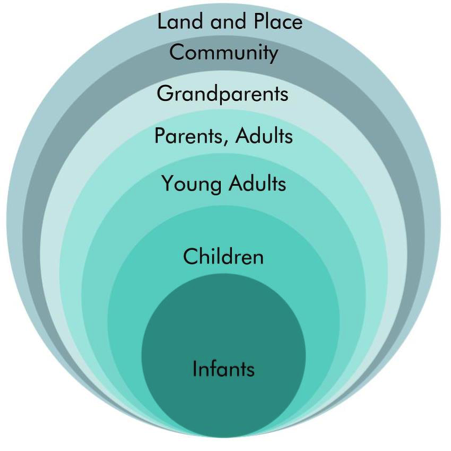Appendix B: SPECIALTYPATHLIST Annotated Diagrams

| Participant/ Contributor Levels | Considerations and questions to ask when using SPECIALTYPATHLIST categories |
|---|---|
| Land and Place | How does your research activity honour the land and acknowledge the Indigenous Peoples of that place?
Are stories or significant cultural areas affected by your research practice and results? Examine whether your research could cause any long-lasting effects to claims and practices of the Indigenous Peoples in that place. How could your research benefit from acknowledging the land and place? |
| Community | Will your research benefit the entire community?
Is there a way you can build your inquiry to support community self-determination? If so, how would the data remain with the community, and how would you describe the results? If your research involves technology, are there physical or virtual technologies you can provide to the community? If so, what would the community require, and does your budget provide an opportunity to bring in technology and materials? |
| Grandparents | If your research is looking at long-term effects or impacts, how could you include Elders and grandparents in your research?
Are there consecutive generations from a family whose stories and life histories can benefit and/or augment your research? Are there social and economic benefits in your research to support older generations’ participation? |
| Parents, Adults | Is there an opportunity to transfer skills and abilities to adults in your research?
Are there appropriate opportunities to include people other than participants in your research process? Has the Indigenous community or authority identified a community-participation requirement for your research? How would you build this into your research design? If your research involves the views of parents of young children, how would you include them in your research? When is the best time to engage for data collection, and how would you share results? |
| Young Adults | Is there an opportunity to include youth voices in your research?
How could their perspectives, attitudes, and aspirations benefit your research results? How would you address any developmental, economic, or educational needs of young adults in your research process? |
| Children | Are there educational or learning elements to your research project that could include or benefit children?
How could you use your results to supplement and support curriculum or cultural transference? Could your results be used in other projects and events to benefit shared learning? |
| Infants | As you design your project, keep in mind how your research can affect new and future generations of Indigenous Peoples.
Will your project benefit or impact infant cultural and social development? How could you engage with families with young infants to add perspective and meaning to your research? |

| Community Levels | Dialogue lead-ins and ethical considerations using SPECIALTYPATHLIST categories |
|---|---|
| Wider Community | As you do your research, what do you need to keep in mind to be accountable to community processes and engagement?
Will there be a need to inform the entire community? If so, how could you do this respectfully and transparently? With your research results, how would and could you share results using community communication techniques (e.g., community events, workshops, newsletters)? Are there any political or economic activities that could impact your engagement or research? How would you identify and modify your research design to ensure minimal risks and address impacts? |
| Participant, Nation | How can you honour contributions to your research project?
What are the physical accommodations you can do to ensure participants are welcomed and their knowledge is used appropriately? Are there any cultural or traditional protocols and processes you need to observe while doing your research? Are there times when you can’t do your research? Consider timing and delivery of your research project. |
| Knowledge Keeper | Determine what traditional knowledge systems and processes can be shared in your research.
Build in mechanisms to protect Indigenous knowledge, and work with knowledge keepers and authorities to ensure your research remains with them and can be used by the community and by you in your career. Respect the time and place of when information is provided, and keep the information intact rather than segmented in your analysis. Ask how to keep the data culturally and spiritually relevant. Be humble in your approach with knowledge keepers, and be patient with how information is shared. Take the time to reflect on responses, and ask for clarification when it is appropriate. |
| Authority, Organization | Explore and discuss the potential linguistic, cultural, and spiritual boundaries of the information shared in your research project.
Ensure that you speak to the appropriate contacts throughout your research project rather than only at the beginning and end. As you gather data, needs and priorities may change, so be consistent and ensure constant check-ins can be built into your research design. |
| Chief, Leadership | Can your research benefit community self-determination and nation building?
Explore how your research design can include results to benefit community, political, and technological advancements. Is there potential for your research to influence or impact legislative and policy processes? |
Media Attributions
- Figure 1: Consultations and Conversations Using SPECIALTYPATHLIST within a Community by L. Neel and D. Biin is used under a CC BY 4.0 Licence.
- Figure 2: Using SPECIALTYPATHLIST as a Dialogue Tool with Community Authorities by L. Neel and D. Biin is used under a CC BY 4.0 Licensc.

